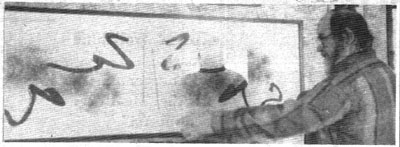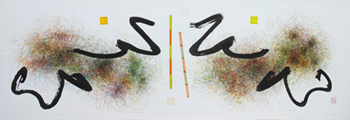<< archive menu | main menu | contact | search | top of page
The document below includes the original 1992 text with bio & exhibition info as published in 1992. The grey photo and publishers logo, shown below, were digitized from an original copy. The color image, added for this web page, is an archival image of the painting shown in the original Edge photo. This work is now located in the collection of the Victoria and Albert Museum in London. December 1992 / January 1993 ° The EDGE ° 5
Computer art wizard expands our parameters of consciousness
The photo above is digitized from the original as it appeared in the Edge article, 1992.
Lung Shan I, 1990, 6 ft long, V & A Museum, London, © Click for detailElectronic artist Roman Verostko in his home studio in South Minneapolis talks about the above 1989 epigenetic painting, produced with the artist's software and executed with a 14-pen Houston Instruments DMP 52 plotter attached to an IBM PC. The brush strokes were made by the program with Chinese brushes adapted to the plotter.
Electronic art wizard Roman Verostko is a visionary capable of expanding the consciousness and parameters of what art is and where it can lead us. Verostko, a professor at the Minneapolis College of Art and Design for over 20 years, executes his paintings with a multi-pen plotter coupled to a PC. His plotter, a computer driven machine, draws from an array of 14 technical pens loaded with inks mixed in his studio. Verostko writes his own software which is capable of executing work in lieu of his own hand. This includes brush strokes made with Chinese brushes mounted on the plotter's drawing arm.
"My approach to art holds a reverence for the materials of earth and a sense of wonder about most things including circuit boards and computer languages. I strive to create well crafted works with iconic qualities that evoke mystery and act as signs pointing to some greater reality," said Verostko. 'The texture and quality of materials are carefully chosen and transformed in the process. For me, the work should have an aura that would draw the casual viewer to pause for a moment and recognize that the work embodies a human endeavor going beyond material concerns."Although he is now married, going beyond material concerns is certainly one of the reasons Verostko spent 16 years as a Benedictine monk. Although Verostko's electronic artwork has only been developed during the past decade, his examination of - control and uncontrol, order and chaos, yin/yang, earth/heaven, man/ woman - explored in his work will certainly influence how we view the world.
"Through this process, in a kind of spiritual quest, one has to empty the self of thinking, be entirely present to the moment, and strive to be one with one's world," said Verostko. "To be one with the brush, the crayon, the panel, the universe, in a free flowing gesture, was indeed the goal."
Verostko writes about the process of uncontrol: "In the initial phases of the computer work, I sought to write a simple program just to sample the use of the computer as a medium - that is, just to get the computing process to generate the work. Step one was to make a scribble loop that would express the inner workings of the computer, similar to the way a Paul Klee doodle expresses the inner life of Paul Klee. That venture was not very successful, but it yielded insight into computerized automatic processes. Successful computer automatism would have to imitate 'automatic art', a genre of artistic activity that began early in this century.
"Automatic art, tachism, and abstract expressionism are terms loosely associated with the idea that one can express something of one's psychic life, something that lies under, above or beyond conscious life, by working in a dreamlike or trancelike state. Such drawing, similar to doodling in an absent-minded state, was practiced by the Surrealists in the 1920s and even earlier by some of the Dadaists."Out of that artistic milieu came artists who learned to enter the frontiers of their inner world; through dreams and free associations, both artists and poets opened a new artistic frontier. My first computer efforts were simple routines to get the computer to mime some of these artistic forays that took place early in this century."
A pioneer in the field of computer art, Verostko is, at this precise moment in time, probably creating "art history". 'These forms are the icons of the new science of Chaos. They reflect the mysterious processes within which our world has evolved," said Verostko. "They participate in shaping the myths that spring forth from the human-machine dialectic. An iconology of these images will see them ultimately as one more step in the evolution of human consciousness exploring the nature of how things get to be the way they are."
Verostko's work may be seen in the foyer gallery of Lamb & Company on the 6th floor at Metrodome Square, 1010 So. 7th St., Minneapolis, Monday - Friday 9 a.m. to 4 p.m.
More about the artist: Roman Verostko teaches art history and humanities at the Minneapolis College of Art and Design. He is Program Chair for the Fourth International Symposium on Electronic Art to be held in Minneapolis in November 1993. He developed the world's first software-driven paintbrush, writes his own software, and has been represented in national and international exhibitions of computer art. In February 1991, St. Sebastian Press published a paperback version of his computer illustrated limited edition of George Boole's Derivation of the Laws of Thought. Verostko's works have been exhibited in dozens of shows and solo exhibitions throughout the world since 1966; he's been featured in dozens of publications and some broadcast documentaries; and he's a well-known international lecturer in the field. Verostko lives with his wife in Minneapolis.
Lynn S. La Froth, Editor
The Edge, December 1992 / January 1993, Page 5
LEAP Publications, Stillwater Minnesota
This issue of the EDGE was titled: "Spiritual & Visionary artists and musicians help transform us".archive menu | main menu | contact | search | top of page


